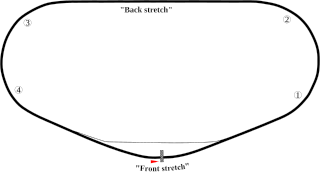The 1971 NASCAR Winston Cup Series season began on Sunday February 14 and ended on Sunday November 20. Richard Petty was the champion for this Winston Cup season. After 20 years of being named the NASCAR Grand National Series, R. J. Reynolds first became the primary sponsor in a decade where the growing anti-tobacco movement banned its advertisement on television and motorsports was the ideal place to place their advertisements. Through NASCAR, Winston merchandise was unveiled to live viewers of the races. This kind of merchandise would also be given out at stores that sold cigarettes in subsequent years. Race car drivers were encouraged to smoke cigarettes until the mid-2000s brought in strict drug testing policies in addition to a smoking cessation program by Nicorette, a GlaxoSmithKline brand.
The 1970 NASCAR Grand National Series season began on Sunday January 18 and ended on Sunday November 22. Bobby Isaac was the champion of the series as NASCAR transitioned from the Grand National era to the Winston Cup era. Only one foreigner was racing that year, a Canadian named Frog Fagan. It was also the last NASCAR national touring series season to feature a dirt track race until the 2013 NASCAR Camping World Truck Series.

The 1970 American 500 was a NASCAR Grand National Series event that was held on November 15, 1970, at North Carolina Motor Speedway in Rockingham, North Carolina. Jim Paschal qualified the #40 vehicle for Pete Hamilton.

The 1968 Rebel 400 was a NASCAR Grand National Series event that was held on May 11, 1968, at Darlington Raceway in Darlington, South Carolina.

The 1973 Rebel 500 was a NASCAR Winston Cup Series race that took place on April 15, 1973, at Darlington Raceway in Darlington, South Carolina.
The 1973 NASCAR Winston Cup Series was the 25th season of professional stock car racing in the United States and the 2nd modern-era Cup season. The season began on Sunday January 21 and ended on Sunday October 21. 31 races were scheduled in the 1973 season. 28 were held.

The 1974 National 500 was a NASCAR Winston Cup Series racing event that took place on October 6, 1974, at Charlotte Motor Speedway in Concord, North Carolina.

The 1974 World 600, the 15th running of the event, was a NASCAR Winston Cup Series event that was held on May 26, 1974, at Charlotte Motor Speedway in Concord, North Carolina.

The 1973 National 500 was a NASCAR Winston Cup Series racing event that took place on October 7, 1973, at Charlotte Motor Speedway in Concord, North Carolina.

The 1975 National 500 was a NASCAR Winston Cup Series race that took place on October 5, 1975, at Charlotte Motor Speedway in Concord, North Carolina.

The 1973 Dixie 500 was a NASCAR Winston Cup Series racing event that took place on July 22, 1973, at Atlanta International Raceway in Hampton, Georgia.

The 1976 Southern 500 was a NASCAR Winston Cup Series racing event that took place on September 5, 1976, at Darlington Raceway in Darlington, South Carolina.

The 1971 National 500 was a NASCAR Winston Cup Series racing event that took place on October 10, 1971, at Charlotte Motor Speedway in Concord, North Carolina. Most of the vehicles used in the race had a rating of 427 cubic inches.

The 1969 Dixie 500 was a NASCAR Grand National Series event that was held on August 10, 1969, at Atlanta International Raceway in Hampton, Georgia.

The 1973 Medal of Honor Firecracker 400 was a NASCAR Winston Cup Series race that took place on July 4, 1973, at Daytona International Speedway in Daytona Beach, Florida.

The 1980 CRC Chemicals Rebel 500 was a NASCAR Winston Cup Series racing event that was held on April 13, 1980, at Darlington Raceway in Darlington, South Carolina.

The 1968 American 500 was a NASCAR Grand National Series event that was held on October 27, 1968, at North Carolina Motor Speedway in Rockingham, North Carolina.

The 1972 American 500 was a NASCAR Winston Cup Series racing event held on October 22, 1972, at North Carolina Motor Speedway in Rockingham, North Carolina. While not televised, the 1972 American 500 was covered by local radio stations WAYN-AM and WEEB-AM.

The 1970 Alabama 500 was a NASCAR Grand National Series event that was held on April 12, 1970, at Alabama International Motor Speedway in Talladega, Alabama. As the inaugural running of what is now known as the GEICO 500, it helped to serve as a prime example of Talladega races yet to come.

The 1974 Southern 500, the 25th running of the event, was a NASCAR Winston Cup Series race on September 2, 1974, at Darlington Raceway in Darlington, South Carolina.







